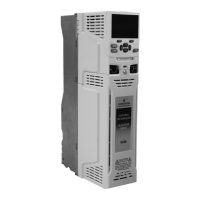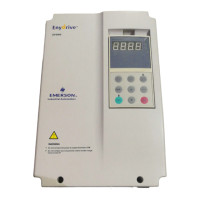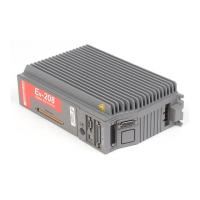Safety
information
Product
information
Mechanical
installation
Electrical
installation
Getting
started
User Menu A Commissioning
Advanced
Parameters
Diagnostics Optimization CT MODBUS RTU Technical Data
E300 Design Guide 395
Issue Number: 1
Internal faults
Trips {HF01} to {HF20} are internal faults that do not have trip numbers. If one of these trips occurs, the main drive processor has detected an
irrecoverable error. All drive functions are stopped and the trip message will be displayed on the drive keypad. The error can only be reset by
powering the drive down and up again. The table below gives the reasons for internal faults and their corresponding trip.
When the drive is subsequently powered up a Stored HF trip is initiated where the sub-trip number is the number of the HF trip that last occurred. This
trip will occur at every power-up until it is reset. The trip can only be reset by first entering 1299 into Pr mm00.
Similar trips that can be initiated by the control system or the power system
Trips shown in the table below can be generated either from the drive control system or from the power system. The sub-trip number which is in the
form xxyzz is used to identify the source of the trip. The digits xx are 00 for a trip generated by the control system or the number of a power module if
generated by the power system. If the drive is not a multi-power module drive then xx will always have a value of 1 the trip is related to the power
system. The y digit is used to identify the location of a trip which is generated by a rectifier module connected to a power module. Where the y digit is
relevant it will have a value of 1 or more, otherwise it will be 0. The zz digits give the reason for the trip and are defined in each trip description.
Braking IGBT
The list below gives conditions that will disable the braking IGBT:
1. Braking IGBT Upper Threshold (D20) = 0, or Low Voltage Braking IGBT Threshold Select (D22) = 1 and Low Voltage Braking IGBT Threshold
(D21) = 0.
2. The drive is in the under-voltage state.
3. A priority 1, 2 or 3 trip is active (see Trip 0 (L29)).
4. One of the following trips is active or would be active if another trip is not already active: OI Brake, PSU, Th Brake Res or OHt Inverter.
Trip Reason
{HF01} CPU has detected an address error
{HF02} CPU DMAC has detected an address error
{HF03} CPU has detected an Illegal op code
{HF04} CPU has detected an Illegal slot instruction
{HF05} An interrupt has occurred that does not have a defined function (Undefined exception)
{HF06} An interrupt has occurred which is reserved (Reserved exception)
{HF07} Watchdog failure
{HF08} CPU Interrupt crash
{HF09} Free store overflow
{HF10} Parameter routing system error
{HF11} Non-volatile memory comms error
{HF12}
S
t
ack overflow. Sub-trip is shown to indicate which stack:
1 – background tasks
2 – timed tasks
3 – main system interrupts
{HF13} The control hardware is not compatible with the firmware. The sub-trip number gives the actual ID code of the control board hardware.
{HF14} CPU register bank error
{HF15} CPU divide error
{HF16} RTOS error (the background task has returned)
{HF17} The clock supplied to the control board logic is out of specification
{HF18}
The internal flash memory has failed when writing option module parameter data.
Sub-trip is shown to indicate which failure:
1 - Programming error while writing menu in flash
2 - Erase flash block containing setup menus failed
3 - Erase flash block containing application menus failed
{HF19} Invalid main application firmware CRC. Reprogramming required.
{HF20} The ASIC is not compatible with the firmware. The sub-trip number displayed is the ASIC version.
{HF23} If this trip occurs please consult the drive supplier.
{HF24} If this trip occurs please consult the drive supplier.
{HF25} If this trip occurs please consult the drive supplier.
Over Volts OHt dc bus
OI ac Phase Loss
OI Brake Power Comms
PSU OI Snubber
OHt Inverter Reserved 102
OHt Power Temp Feedback
OHt Control Power Data

